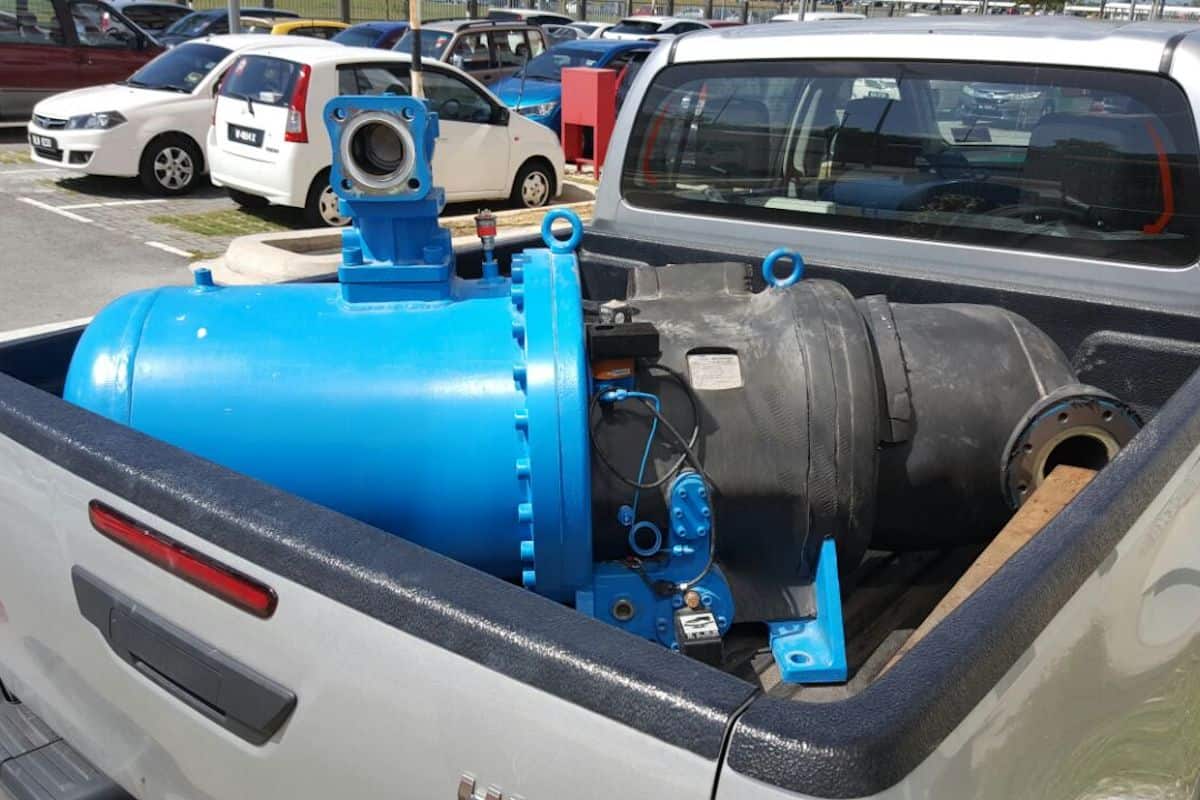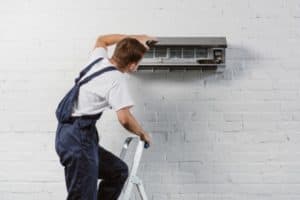3 Types of Compressors in HVAC (Applications & Characteristics)
Compressor is the heart and soul of air conditioners in HVAC. It is the most important component of an air conditioner and chiller. However, there are many types of compressors in HVAC. So, let’s take a closer look at their applications and characteristics.
There are 3 common types of compressors in HVAC as follow:
- Scroll Compressor
- Centrifugal Compressor
- Screw Compressor
Every compressor has the same objective but they work differently and thus, they are used in different air conditioners and chillers. Understanding the different types of compressors can help improve your design and troubleshooting skills.
1. Scroll Compressor
Scroll compressor is the most common type of compressor in HVAC. Scroll compressors are widely used in residential air conditioners as well as some commercial air conditioners.
Generally, a scroll compressor can be identified by its black color or blue color and cylindrical-shaped body. The maximum capacity of a scroll compressor is often capped at 30 HP.
Scroll compressors are usually rated in HP (horsepower) where 1 HP is equivalent to about 0.75 RT (refrigeration tonnage) or 9000 BTU.
See my post BTU to HP | BTU to Ton | BTU to kW | Conversion Tables for more details about the unit conversion for air conditioner capacity.
A scroll compressor is also known as a hermetic compressor.
A hermetic compressor means that the compressor motor and the compressor blade are placed together in a sealed chamber. Such a compressor design is very compact and thus, well suited for small air conditioners such as residential split (mini split) air conditioners.
However, the downside of a hermetic compressor is unable to repair. So, if a scroll compressor breaks, a new scroll compressor is needed.
Some of the common air conditioners that use a scroll compressor are as follow:
- Single-split air conditioners (single-zone mini splits)
- Multi-split air conditioners (multi-zone mini splits)
- VRF/VRV air conditioners
- Air-cooled chillers
Commercial air-cooled chillers often use multiple scroll compressors to achieve high cooling capacity. Besides, hot water heat pumps (air source & water source) also use multiple scroll compressors to produce hot water.

By having multiple scroll compressors, air-cooled chillers and hot water heat pumps can reduce their capacity in a stage-by-stage manner. For example, a 60 RT air-cooled chiller may have 4 scroll compressors with each compressor having a capacity of 20 HP.
So, with 4 scroll compressors, the 60 RT air-cooled chiller can have a 4 stages capacity control. For instance, its capacity may be separated into 25%, 50%, 70% and 100% with each stage of capacity corresponding to the number of scroll compressors in operation.
Hence, the capacity control mechanism is simple and reliable.
In addition, a VFD (variable frequency drive) can be included in the air-cooled chiller to further regulate its capacity to achieve more than just 4 stages. For example, the air-cooled chiller can operate at a capacity anywhere from 10% to 100%.
The VFD is able to manipulate the speed of each scroll compressor motor to allow precise capacity control and thus, produce the capacity as needed only thereby saving energy and cost.
Most of the time, air-cooled chillers are able to continue operation when one or two of their scroll compressors malfunction. They simply run at 50% of their total capacity if 2 out of 4 scroll compressors breakdown.
However, the downside of having multiple scroll compressors is the high maintenance cost.
More compressors don’t necessarily make it better. In fact, there are more things to be taken care of. Hence, due to high workload, stress and other factors, maintenance personnel may not carry out their duty promptly thereby increasing the chance of scroll compressor failure in air-cooled chillers.
Nonetheless, scroll compressors are easy to find a replacement for since they are widely used in both residential and commercial buildings. Besides, replacing a scroll compressor with a different brand but similar specification often works.
In the meantime, I would like to inform you that you can learn quicker by getting my HVAC Begin (eBook) if you’re a beginner. But, if you have a year or two of experience, then I would suggest you consider my HVAC Basics (eBook). Nonetheless, I encourage you enroll in my HVAC Beginner Course: 10 Days to Become Competent in HVAC if you want to equipped yourself with a complete set of basic HVAC skills.
HVAC Beginner Course
Learn the most basics and foundational HVAC skills including cooling capacity calculation, equipment selection, duct sizing, pipe sizing, exhaust fan sizing, controls, electrical and more.
2. Centrifugal Compressor
Centrifugal compressor perhaps is the second most common type of compressor in HVAC. However, centrifugal compressors are mostly used in commercial water-cooled chillers.
Centrifugal compressors are huge with high capacity. A typical water-cooled centrifugal chiller can have a cooling capacity of up to 4000 RT with a dual centrifugal compressor setup. The lowest capacity for a centrifugal compressor is around 100 RT.
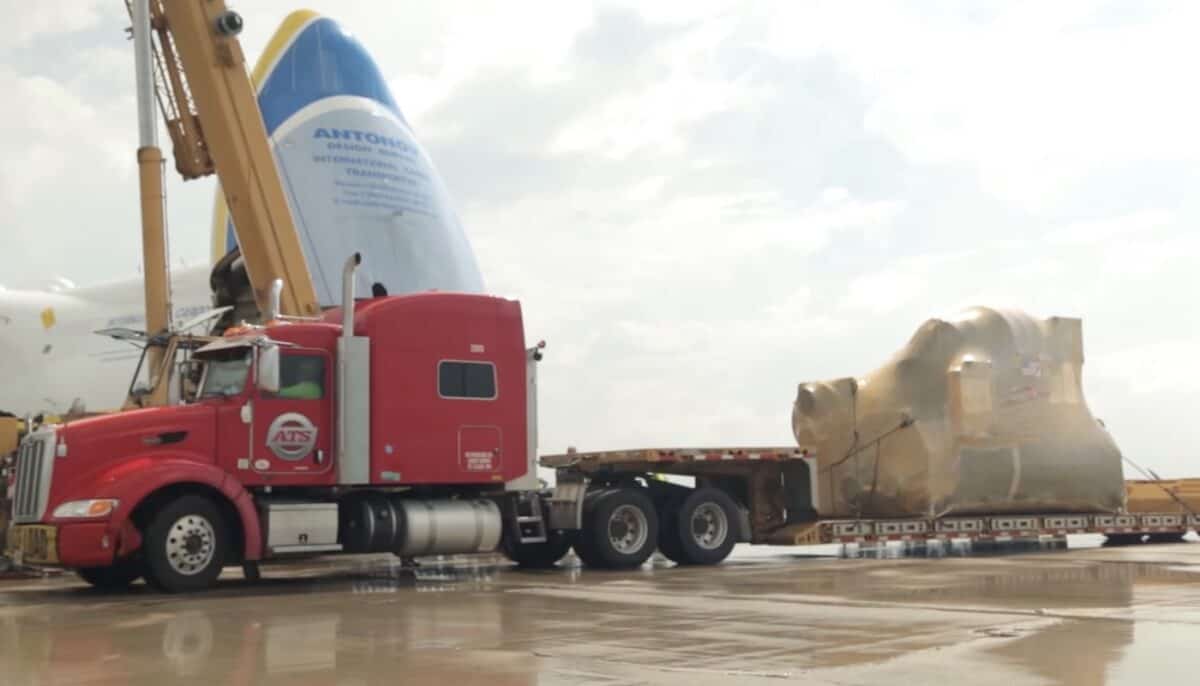
A standard water-cooled chiller can have one or two centrifugal compressors depending on the capacity needed. Needless to say, one centrifugal compressor yields a lower capacity than two centrifugal compressors.
Traditionally, centrifugal compressors are lubricated with oil just like car engines. Hence, maintenance is needed to ensure that the quality of the oil (lubricant) is good. Nowadays, centrifugal compressors can be oil-free and it is known as magnetic bearing centrifugal compressor.
Water-cooled chillers that use the magnetic bearing centrifugal compressor are known simply as magnetic bearing centrifugal chillers or oil-free magnetic bearing chillers.
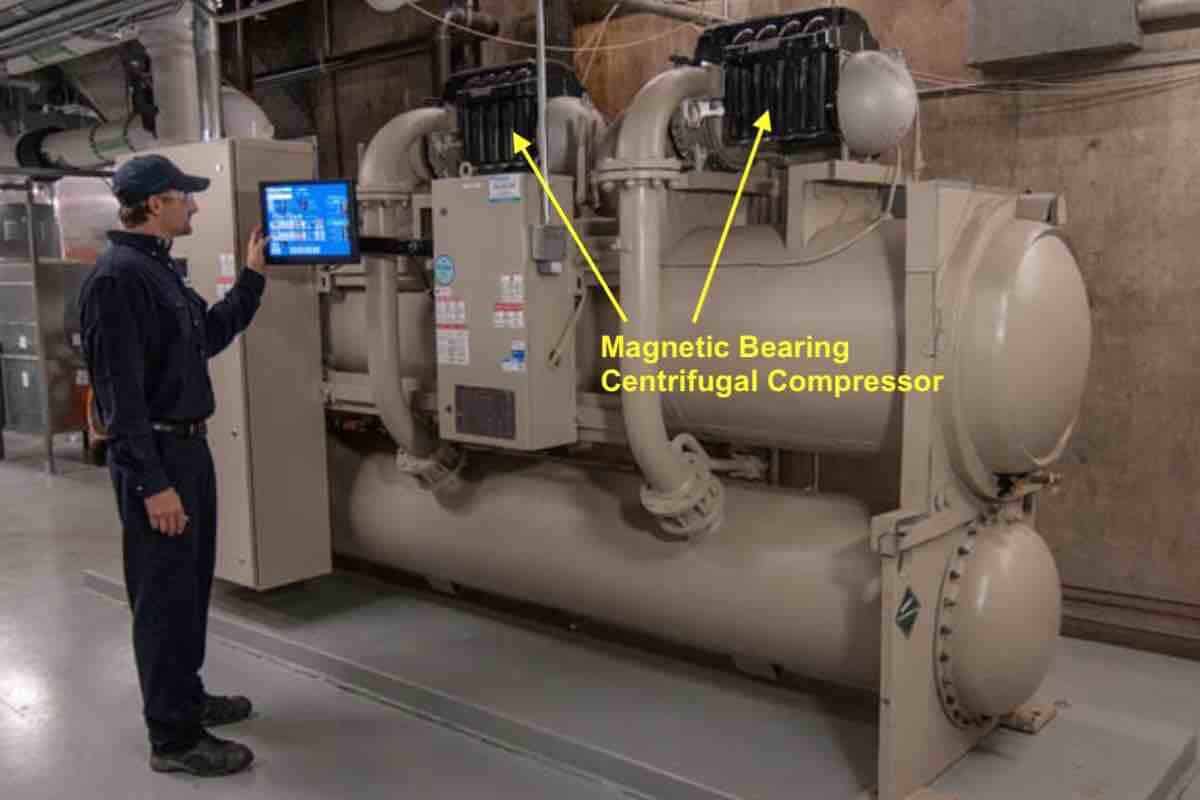
Basically, magnetic bearing centrifugal compressors don’t need lubricant because they levitate by the force of the magnetic field. So, they are more efficient and cheaper to maintain.
However, magnetic bearing chillers are more expensive and the highest capacity available is around 1600 RT only.
Including the magnetic bearing type, centrifugal compressors in general are prone to surge. See my post Chiller Surge: Symptoms, Causes & Preventions for comprehensive details.
Basically, a centrifugal compressor does not mechanically push the refrigerant. Instead, it rotates quickly to generate kinetic energy that compresses the refrigerant. Hence, if the output pressure is higher than the pressure limit of the centrifugal compressor, the refrigerant can flow backward which affects the performance of the chiller.
Such a problematic phenomenon is often due to low cooling demand.
Hence, modern water-cooled centrifugal chillers have several preventive measures to ensure that centrifugal compressor surging does not occur.
Conventionally, centrifugal compressors are semi-hermetic compressors, meaning that the compressor motor and the compressor blade are placed together in a sealed chamber. Still, the chamber can be opened for service and repair.
However, several new water-cooled centrifugal chillers have open compressors, meaning that the motor of the centrifugal compressor is not sealed together with the compressor blade. Therefore, service and repair are easier and faster since the compressor chamber is not required to be opened.
Water-cooled centrifugal chillers that use open compressors are often known as open-drive chillers.
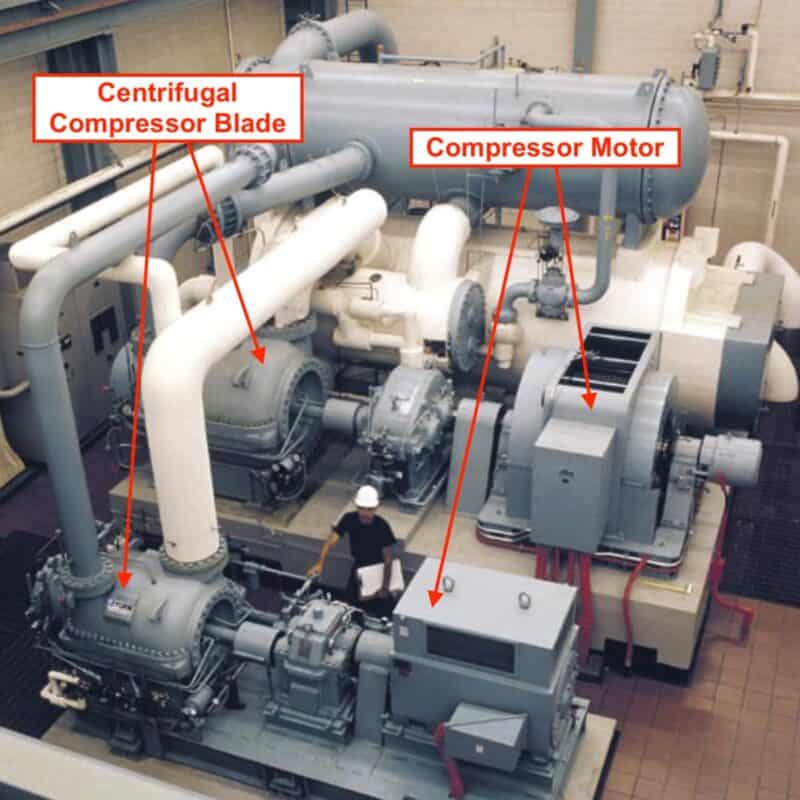
Open drive chillers improve the efficiency of the chiller itself because the refrigeration system doesn’t need to account for the heat generated by the compressor motor.
However, the compressor motor releases a significant amount of heat normally cooled by the refrigerant to the chiller plant room. So, separate cooling or ventilation may be needed for the chiller plant room.
Nonetheless, applications that required minimal downtime such as production plants, factories and laboratories often prefer water-cooled centrifugal chillers with the open-drive design.
3. Screw Compressor
Screw compressor is a common type of compressor in HVAC. Screw compressors are mostly found in water-cooled chillers. However, high-capacity air-cooled chillers also use screw compressors.
While a scroll compressor air-cooled chiller has a maximum cooling capacity of around 250 RT, a screw compressor air-cooled chiller has a maximum cooling capacity of around 500 RT.
Unlike scroll compressors, the capacity of an air-cooled chiller driven by screw compressors increases corresponding to the size of the screw compressor. In other words, the bigger the screw compressor, the greater the capacity.
However, more than one screw compressor may be used for high-capacity units.
It is relatively easy to identify between a scroll and a screw compressor air-cooled chiller as a screw compressor air-cooled chiller has a big horizontal compressor.
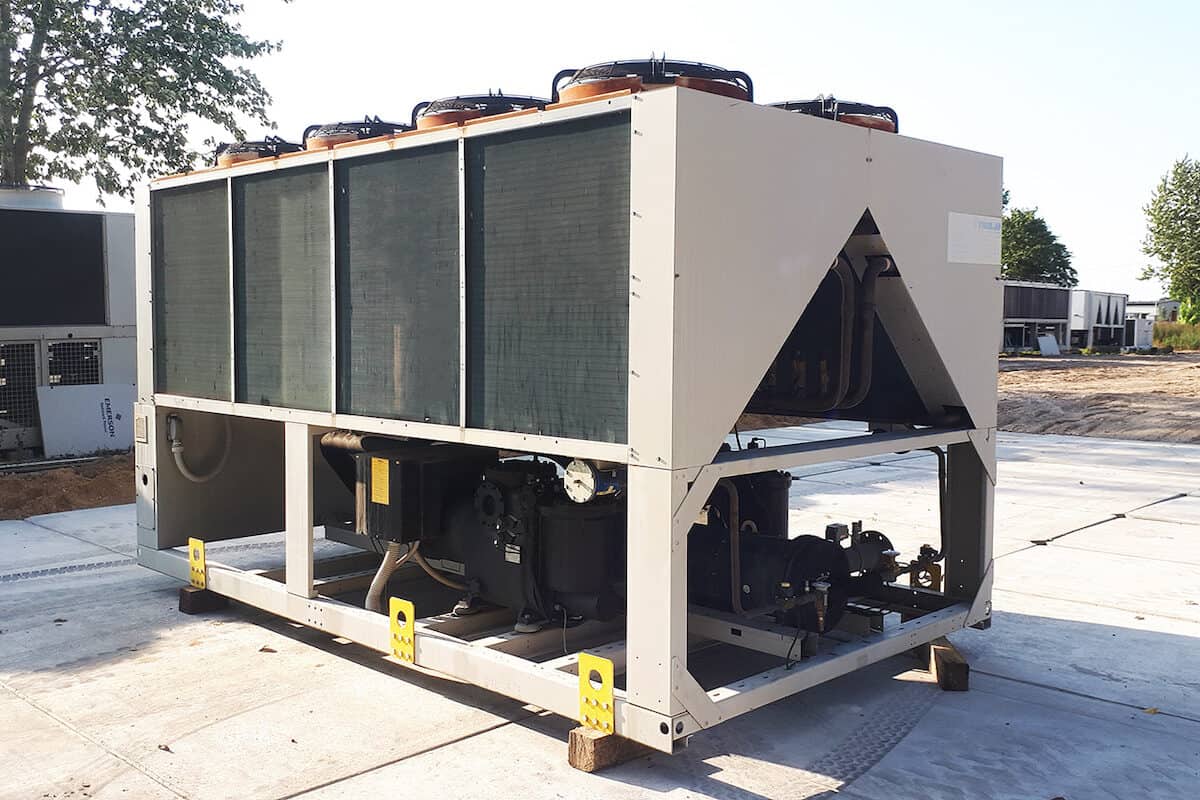
A screw chiller is also known as a helical rotary chiller.
A screw compressor can have a single screw or two screws. A chiller with a two-screw compressor is often known as either a twin-screw chiller or a dual screw chiller.
Generally, a single screw compressor chiller has a maximum cooling capacity of around 250 RT, much like a scroll compressor chiller. Meanwhile, a twin-screw compressor chiller has a maximum cooling capacity of around 500 RT.
Hence, air-cooled chillers often use a single screw compressor while water-cooled chillers often use the twin-screw compressor.
Poor quality screw compressors can result in loud and unpleasant noise as the twin-screw compressor is not perfectly fit and scrub at each other during operation. Consequently, apart from being very noisy, the lifespan of the compressor is also reduced.
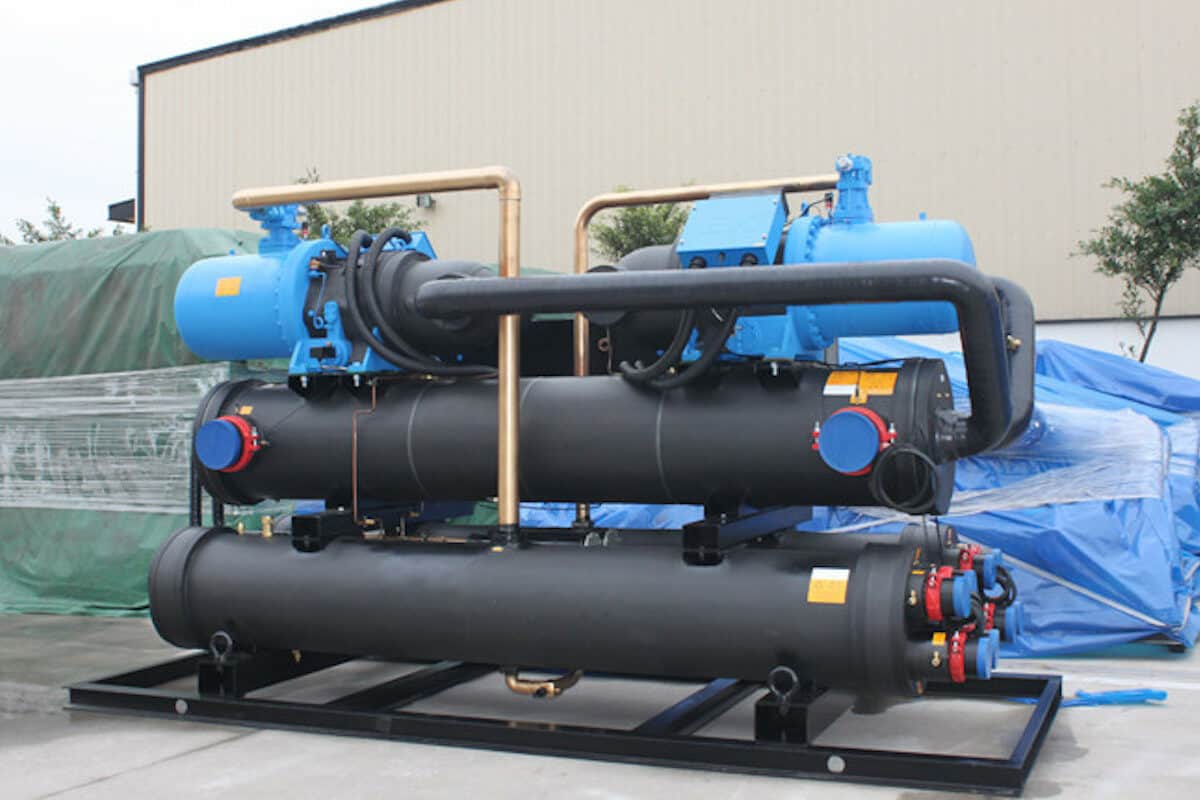

Conclusion
In HVAC, each type of compressor has its own pros and cons and applications. Generally, scroll compressors are for small cooling applications while screw compressors and centrifugal compressors respectively are for medium and large cooling applications.
Lastly, centrifugal and screw compressors are mostly found in commercial air conditioners and scroll compressors are mostly found in residential air conditioners.
Lastly, consider my HVAC Begin (eBook) if you’re a beginner and you want to have a foundational knowledge in HVAC. But, if you have a year or two of experience, then I would suggest you consider my HVAC Basics (eBook). Nonetheless, I encourage you enroll in my HVAC Beginner Course: 10 Days to Become Competent in HVAC if you want to equipped yourself with a complete set of basic HVAC skills.
HVAC Beginner Course
Learn the most basics and foundational HVAC skills including cooling capacity calculation, equipment selection, duct sizing, pipe sizing, exhaust fan sizing, controls, electrical and more.
If you have anything to add (or ask) about this topic, leave a comment down below!


